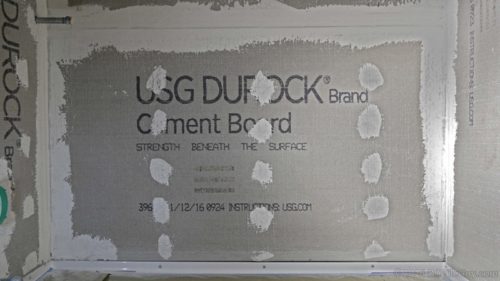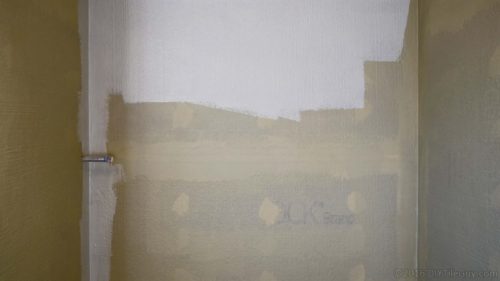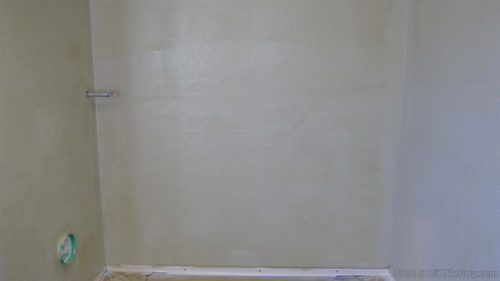Reader question: Hi there. I recently finished grouting my tile surround in my shower. I posted photos on Facebook and somebody questioned whether I had waterproofed the Hardiebacker 500 board. Much to my dismay, I had never even heard of this…
Anyway, I went to the James Hardie website and see nothing about waterproofing being required… In my research, and reading forums, it seems quite evident that it is needed.
I am not somebody that skimps out or cuts corners. I simply have never come across this… VERY FRUSTRATED!!! DAMN YOU HOME DEPOT :)

This is a common question.
Furthermore, the last thing a contractor needs is for the whole Facebook community to be criticizing how a shower was constructed.
However, after researching the manufacturer instructions for each backer board I find the confusion on the matter is understandable.
Is cement board waterproof?
Tile contractors have a “bible” from an organization called the Tile Council of North America (TCNA). Here’s what the TCNA handbook has to say about the matter:
A waterproof membrane or vapor retarder membrane must be specified to prevent moisture intrusion and protect adjacent building materials.
B412 Bathtub or shower with prefabricated receptor. Cement board or Fiber-cement board. Ceramic Tile.
What do cement board manufacturers say?
This seems quite clear. Yet, it seems like where the confusion comes in is when you look at the different backer board manufacturer’s instructions. Hence the question “Is cement board waterproof?” Well, here’s what some manufacturers have to say about waterproofing:
- PermaBase (National Gypsum): PermaBase PLus is not a water barrier. Consult local building code for moisture barrier requirements
- Wonderboard (Custom Building Products): See update below
WonderBoard® Lite is not a waterproof barrier. If the area behind the backerboard must be kept dry, use RedGard® Waterproofing and Crack Prevention Membrane or Custom® 9240 Waterproofing and Anti-Fracture Membrane - Durock (USG): If waterproofing is desired, use USG Durock™ Tile Membrane or USG Durock™ Brand Waterproofing Membrane
- Hardiebacker (James Hardie): the use of a waterproof membrane, vapor barrier or vapor
- retarding membrane is optional unless the local building code requires it
Update: Custom Building Products has changed its stand on this since I originally wrote it. Here is the latest:
- A moisture barrier must be installed to protect the wall cavity for wet area installations. Nail or staple 15 lb roofing felt or 4 mil polyethylene sheeting to the studs… Any shelf, ledge or horizontal surface subjected to water exposure must have a slight downward slope for water runoff. These areas also require proper waterproofing. ~WonderBoard® Lite Backerboard / TDS266 3/29/2018
Consult local building codes. Talk about passing the buck. In fact, they may even be vague on purpose.
Which cement board do you think will sell better: Brand A (waterproofing unnecessary) or Brand B (waterproofing definitely required)?
Shower Waterproofing Crash Course

“If waterproofing is desired…”
Who builds a shower and doesn’t desire waterproofing?
Furthermore, the problem is that most people who purchase the backer board from a big box retailer don’t have access to a TCNA Handbook.
Certainly, it seems like better instructions are necessary if more waterproof showers are to be achieved.
In fact, here’s where things get really dicey: if there’s a horizontal surface in a wet area it’s absolutely critical that it gets waterproofing applied to it.
Because if it doesn’t then failure isn’t just a possibility but rather nearly guaranteed. However, where is that in the cement board instructions?
A three-wall tub surround could possibly survive with no waterproofing.
However, a shower with a bench and a half wall is almost certainly doomed to failure. Certainly, this is no time to be vague on whether the cement board is waterproof.

How should cement board be waterproofed?
How exactly does one go about waterproofing a shower, a tub alcove, or a wet area? In other words, how do you make cement board waterproof?
Well, the very minimum would be to install a sheet of 4 mil plastic behind the cement backer board or Hardiebacker.
However, if you are waterproofing horizontal surfaces like a shower bench then plastic isn’t good enough. You need a topical waterproofing system on these critical areas.
Knowing how to waterproof the bathtub flange is also important.
In the case of the reader above, the Facebook criticism was harsh but the internet is helping to get instructions out that cement board manufacturers have been hesitant about.
Hopefully, shower waterproofing instructions will continue to become more transparent in the future.
Remember, if you aren’t working in a wet area then tiling over drywall is often perfectly acceptable.